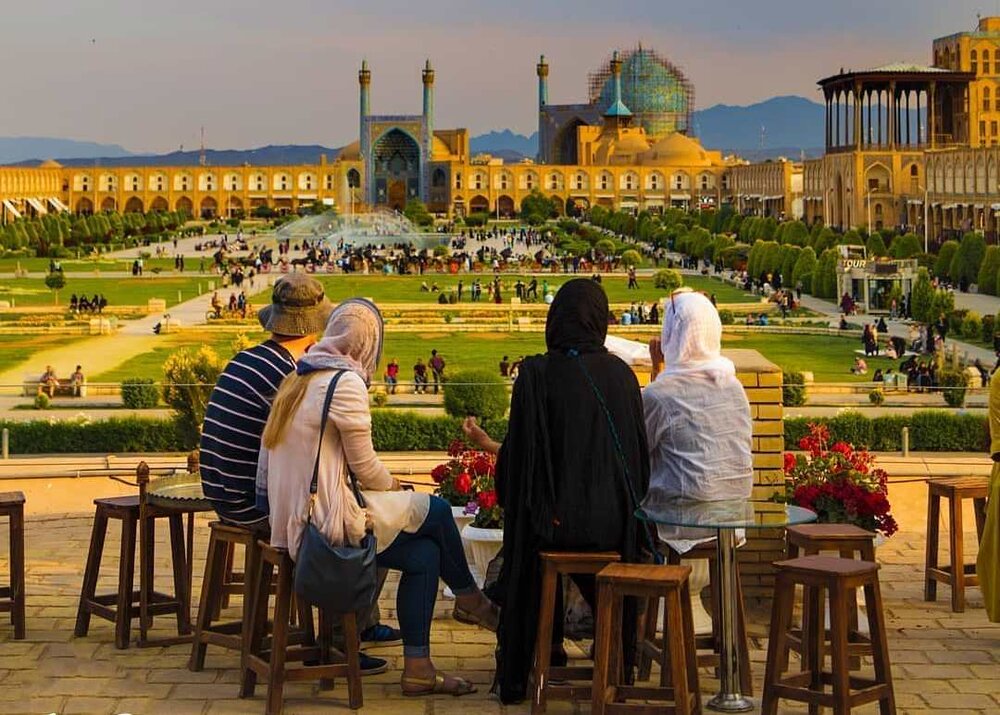Naqsh-e Jahan, the second largest square in the world, is one of the most eye-catching squares, where its vibe will take you back to three hundred years ago! When the kings of the Safavid would rule the country.
Where is Naqsh-e Jahan Square?
Naqsh-e Jahan Square, is located in the city of Isfahan in Iran. Isfahan is one of the central cities of Iran, reputed for the Zayandeh Rud river passing through the city. Isfahan is known as the capital of arts and culture not only in Iran, but also in the entire Islamic world.
The city mainly owes its reputation to the mesmerizing architecture and arts of the Safavid period, from the 16th to 17th centuries. Naqsh-e Jahan Square includes some of the most symbolic landmarks of the time. As such, Isfahan is also known as the city of blue domes.
History of Naqsh-e Jahan Square
To tell the story of Imam Square, we need to flashback to the 16th century, when the Safavid Dynasty ruled over Iran. Back then and the city of Ardabil, in the northwest of Iran, was the capital of Iran. Being in war with the Ottoman empire and the desire to have better access to the southern ports of the country, made Shah Abbas the Great, king of Persia at the time, move the capital to Isfahan.
This is how the beautiful city of Isfahan became home to the royal house. The Shah ordered to build royal buildings in the city, and Sheikh Baha’i became the mastermind behind Naqsh-e Jahan Square. Its construction was completed between the years 1598 and 1629.
Structure of the square
The square is 160 meters wide and 560 meters long. It concentrated the three pillars of the royal power in one place, with the Ali Qapu Palace on the west side, Shah Mosque on the south side, Sheikh Lotfallah Mosque on the eastern side, and the Qyesarieh Gate, which opened to the Grand Bazaar, on the northern side. These buildings have been connected to one another by rows of two-story shops. They also included coffee-houses and caravanserais. In addition to the shops, the tradesmen and entertainers set up tents in the square.
Usage of the square
The square played an important role in Isfahan’s economic prosperity, as it functioned as a major stop along the Silk Road. It was a great place for not only commerce but also entertainment. You can imagine the buzz of a place filled with merchants, shop keepers, and shoppers.
However, every now and then, this hustle and bustle was put to stop. This usually happened when the royal household wanted to make a visit to the mosques or go for a walk. The Shah was also a big fan of “Chogan Bazi”, a sport that dates back to the Achaemenid Empire, nowadays known as polo. So, the square turned into a game court, while the royals from Ali Qapu mansion’s terrace and commoners in shops watched the game.
Location of Naqsh-e Jahan Square
To understand the location of Naqshe Jahan Square, we should first take a look at the city’s structure. Isfahan was established in the northern side of the Soffeh mountain. Here Zayande Rud passes through the center of the city, dividing it into two northern and southern sections.
Back in the day, the square was built in the center of Isfahan. It was located on a relatively close distance north of the gushing Zayande Rud river. As such, the northern side of the city grew and prospered faster in the beginning.
Gradually, several mansions were built in the vicinity of the square for members of the royal household. Chehel Sotun Palace, Hasht Behesht and Jahan Nama Palace were built from west to south of the square. In addition to these, the Chahar Bagh Royal Promenade was built on a location close to the square. It stretched all the way to Zayande Rud river and provided a charming environment for passersby.
What to do in Imam Square?
Naqsh-e Jahan Square of Isfahan is the symbol of the city. Here, colors, tastes, smells and senses of Isfahan’s past and present come alive. Listen to the hammering sound of the coppersmiths, and watch artists remodel the heavens on Minakari vessels. Smell the wonderful scent of spices, and join in the experience of tastes come together in the feast of Persian food.
Visiting Mosques
More interesting things to do in Shah Square are touring around Sheikh Lotfollah Mosque and Shah Mosque. These mosques carry centuries-old stories and let their visitors join in communal and religious experiences related to their buildings. In Sheikh Lotfallah Mosque you can see one of the most elaborately designed high rising domes in the world. Stand in the center and speak a word, can you hear your voice eco tenfold stronger? At Shah Mosque, also called Imam Mosque and Imam Masjid, the portal rises to the heavens in stunningly symmetrical Muqarnas vaults.
Ali Qapu and Qeisariey
You can also walk up the spiraling steps of Ali Qapu Palace and be amused by the details of Safavid arts and architecture. Its top floor terrace opens to the square, where once kings sat and watched the games played in the square. And if you ever wonder if Shah Abbas was a fan of music, you should visit his exclusive music room. Another possibility is visiting the Qeysarie Gate, now turned into a museum and a café. Fancy looking at the square from the perspective of Qajar kings? Then Qeysarie Gate is your spot!
Carriage in Naghshe Jahan Square
Walking in the square is always a good idea, but maybe not so much if you are weary of the day’s adventures around Isfahan. If so, you can hop one of the horse carriages and get around the square. This will give you a general sense of the square colored by a tint from the past when horse carriages were a thing. In addition to this, rental mini cars can help you have a fun experience of going around the square.
Bazaar
The bazaars of Naqsh-e Jahan Square are visitors’ favorite. You can explore the corners of the bazaars, learn about Iranian arts, socialize with the locals and shop for souvenirs. But what no one should miss here, is the hidden tea house known as Chah Haj Mirza, or Azadegan Tea House. Antique objects have taken over the walls and roof of the place. Inside the tea house, you can feel transported to another place, another time. But if you want a traditional cold drink to quench your summertime thirst, then Roozegar Sherbet House is your place.
Chah Haj Mirza
Chah Haj Mirza is perhaps the most interesting traditional café and restaurant in Naqsh-e Jahan Square. You can enjoy your tea or meal in an area covered by antique objects. Each part of the walls in this café tells unheard tales of not only the place but also the city.
When to Visit Naqsh-e Jahan Square
As it goes with the name, the square is more like a public place where you can visit any time of the day. The lights turned on at night multiply the square’s charms, making it an ideal place for taking a walk around the place, having dinner, or relaxing. However, you can make the most of their day if you visit Imam Square by the day. During the day, the historical monuments welcome visitors until 5 p.m. Also, the shops are open until around 9 p.m.
Naghsh-e Jahan Square’s Address
Ostandari Street, Isfahan, Iran
Thanks to its location, several streets lead to the square, which makes it quite accessible for everyone. However, if you ask locals, they will quite often direct you to Ostandari street. Here you can enter the square through two gates, towards the north and south of the square.



Comment (0)